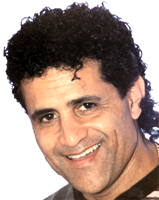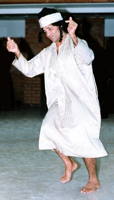
|
The Society of Folk Dance Historians (SFDH)
Yemenite Jewish Dance
[
Home |
About |
Encyclopedia | CLICK AN IMAGE TO ENLARGE |

|
The two main subjects that influenced the Yemenite Jews and kept them devoted to their culture are the "Torah" (the Bible) and "Eretz Yisrael" (Israel – the holy land). These two are the main focus of their songs and dances. In Yemenite tradition, there is a very clear difference between the songs and dances of the men vs. the women.
MEN'S DANCES

 Among the men, the dance has a functional purpose, and we have to look for ceremonial reasons for it. The men dance for family occasions in the life cycle, or a religious event in the year's cycle. In some occasions it is almost a requirement, as in a wedding wherein the men dance to make the bride and groom happy by dancing with them. To accompany the dance other men will sing an appropriate song that fits the event, often expressing yearning for the holy land, and hope for redemption.
Among the men, the dance has a functional purpose, and we have to look for ceremonial reasons for it. The men dance for family occasions in the life cycle, or a religious event in the year's cycle. In some occasions it is almost a requirement, as in a wedding wherein the men dance to make the bride and groom happy by dancing with them. To accompany the dance other men will sing an appropriate song that fits the event, often expressing yearning for the holy land, and hope for redemption.
One man will start the dance on his own, and will challenge other men to join him. The coordination between the dancers is usually done by eye contact and small body gestures that allow them to improvise while dancing together. Another element of the dance is the contact with the singer(s) that determine the rhythm; this also is accomplished by eye contact and vocal expressions.
The women will never dance with the men in the same room; it is forbidden by religious laws. Their dance is very different from the men's for many reasons. The songs that they dance to are not written, but done by memorizing the words and passing them from generation to generation. The subjects of the songs are of every-day life: love, hate, jealousy, etc. They are all sung in Arabic only, and usually by the women who can sing while they dance.
For a wedding, there is a bridal shower with a song for that occasion. Also, one for the bridal preparation ceremony, and one for the procession of the bride to the wedding. The latter is done with metal plates with a candle and flowers on them on the head of those doing the singing and dancing. All dancing is accompanied by singing because musical instruments, except for percussion, were forbidden.
DOCUMENTS
- Jews, a culture.
- Yemen, a country.
- Yemenite Dancing, an article.
Excerpted from an article by Israel Yakovee in 1989.
Printed in Folk Dance Scene, June/July 2009.
This page © 2018 by Ron Houston.
Please do not copy any part of this page without including this copyright notice.
Please do not copy small portions out of context.
Please do not copy large portions without permission from Ron Houston.
